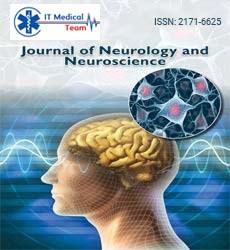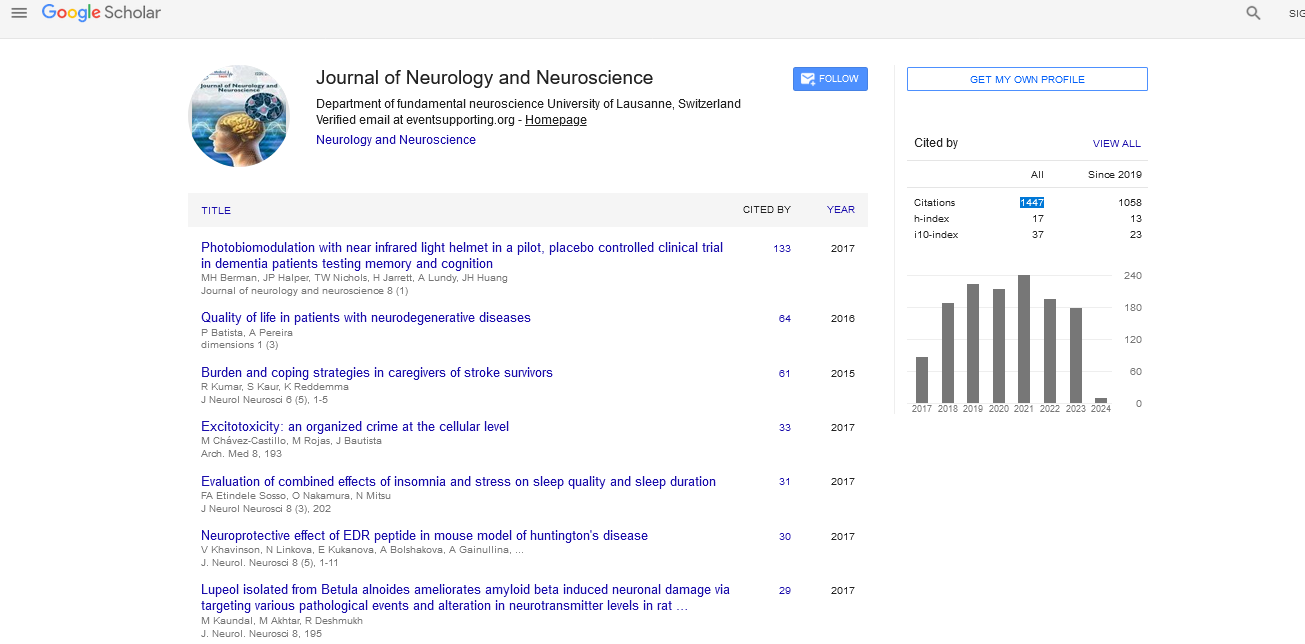Opinion - (2025) Volume 16, Issue 1
Blood–brain barrier modulation through nanomedicine: Implications for neuroprotection and neuroregeneration
Gangwar Hwang*
Department of Family Medicine, Community Health Center Krapina, 49000 Krapina, Croatia
*Correspondence:
Gangwar Hwang, Department of Family Medicine, Community Health Center Krapina, 49000 Krapina,
Croatia,
Email:
Received: 30-Jan-2025, Manuscript No. ipjnn-25-15564;
Editor assigned: 01-Feb-2025, Pre QC No. P-15564;
Reviewed: 14-Feb-2025, QC No. Q-15564;
Revised: 20-Feb-2025, Manuscript No. R-15564;
Published:
27-Feb-2025
Introduction
The Blood-Brain Barrier (BBB) serves as a crucial
selective barrier, protecting the brain from potentially harmful
substances while regulating the transport of essential nutrients
and maintaining the homeostasis of the Central Nervous
System (CNS). However, this protective feature also presents
a significant challenge for the delivery of therapeutic agents to
the brain, particularly in the treatment of neurological diseases
such as Alzheimer's, Parkinson's, stroke, and traumatic brain
injury. The inability to effectively deliver drugs across the
BBB has been a major obstacle in the development of novel
therapies for these conditions. Recent advancements in
nanomedicine have opened up new possibilities for modulating
the BBB and enhancing the delivery of therapeutic agents to
the brain, offering potential solutions for neuroprotection and
neuroregeneration [1].
The BBB is a highly specialized, semi-permeable barrier
formed by endothelial cells lining the blood vessels of the
brain. These cells are tightly joined by tight junctions that
restrict the passage of large molecules, pathogens, and toxins,
while allowing the selective transport of nutrients and small
molecules. The BBB also functions to protect the brain from
fluctuations in blood composition and maintain the delicate
environment required for neuronal function. While this selective
permeability is critical for normal brain function, it becomes
problematic when therapeutic agents need to be delivered to
treat neurological conditions. In many neurodegenerative
diseases and brain injuries, the BBB can become compromised,
leading to increased permeability and the potential for harmful
substances to enter the brain. This phenomenon is a doubleedged
sword: while it can allow for the entry of drugs and
therapeutic agents, it also increases the risk of inflammation,
oxidative stress, and neuronal damage. Therefore, modulating
the BBB in a controlled manner is a promising strategy for both
neuroprotection and neuroregeneration [2].
Description
Nanomedicine refers to the application of nanotechnology
in the medical field, particularly in the delivery of therapeutic
agents at the molecular and cellular levels. Nanoparticles
(NPs) are engineered materials that typically range from 1 to
100 nanometers in size. Due to their small size, large surface
area, and unique physicochemical properties, nanoparticles can
interact with biological systems in ways that bulk materials
cannot, making them ideal candidates for drug delivery and
therapeutic interventions. When it comes to BBB modulation,
nanoparticles have the potential to overcome the challenges
associated with crossing the BBB by exploiting various
mechanisms to enhance drug delivery. Several strategies have
been proposed to utilize nanoparticles for BBB modulation,
including receptor-mediated transport, nanoparticle surface
modification, and the use of nanoparticles to temporarily
disrupt the tight junctions of the endothelial cells forming the
BBB [3].
One of the most widely studied approaches for enhancing
drug delivery across the BBB is receptor-mediated transport.
The endothelial cells of the BBB express a variety of receptors
on their surface that are involved in the transport of nutrients,
hormones, and other essential molecules. Nanoparticles can
be functionalized with ligands that specifically target these
receptors, allowing for the selective transport of nanoparticles
across the BBB. Common receptors targeted for this purpose
include the transferrin receptor (for iron transport) and the insulin
receptor (for glucose transport). By conjugating nanoparticles
with these targeting ligands, researchers have been able to
design drug delivery systems that can cross the BBB more
effectively. For example, transferrin-conjugated nanoparticles
can bind to the transferrin receptor on the endothelial cells,
facilitating the transcytosis of the nanoparticles across the BBB
and enabling the delivery of therapeutic agents to the brain.
This approach has shown promise for the delivery of drugs in
the treatment of neurological diseases such as Alzheimer's and
Parkinson's disease.
In addition to receptor-mediated transport, the surface
properties of nanoparticles can be engineered to enhance
their ability to cross the BBB. Nanoparticles can be modified
with coatings that increase their stability in the bloodstream
and improve their interaction with the endothelial cells of the
BBB. For instance, coating nanoparticles with Polyethylene
Glycol (PEG) can reduce their recognition and clearance by
the immune system, allowing them to circulate longer in the
bloodstream and improving their chances of reaching the brain.
Surface modification can also be used to increase the
affinity of nanoparticles for the BBB. By attaching targeting
peptides or antibodies to the nanoparticle surface, researchers
can direct the nanoparticles to specific regions of the brain.
This targeted delivery not only improves the efficiency of drug
delivery but also reduces the risk of side effects by limiting
the exposure of peripheral tissues to the therapeutic agents [4].
Neuroprotection refers to strategies aimed at preventing
or slowing down neuronal injury and death in neurological
diseases. Nanoparticles can be used to deliver neuroprotective
agents, such as antioxidants, anti-inflammatory drugs, or gene
therapy, directly to the brain. For example, nanoparticles
loaded with compounds like curcumin or resveratrol, both of
which have known neuroprotective properties, can be targeted
to brain regions affected by neurodegenerative diseases.
By crossing the BBB and delivering these agents to the site
of injury, nanoparticles could potentially prevent or reduce
neuronal damage and slow disease progression. Additionally,
nanoparticles can be used to deliver small interfering RNAs
(siRNAs) or other gene therapy agents that can silence genes
responsible for neuronal degeneration. Gene silencing strategies
have shown promise in conditions like Alzheimer's disease,
where amyloid-beta plaque accumulation is a key pathological
feature. By targeting the specific genes involved in disease
progression, nanoparticles could play a crucial role in halting
or reversing neuronal damage. Nanoparticles can be engineered
to carry molecules like Brain-Derived Neurotrophic Factor
(BDNF), which promotes the growth and survival of neurons.
By targeting these nanoparticles to the brain, researchers can
create a localized environment that supports neuronal repair.
Additionally, nanoparticles can be used to deliver stem cells to
injured brain regions, facilitating tissue repair and functional
recovery. Nanoparticle-based scaffolds could also be used to
guide the growth of new neurons and synapses, promoting
regeneration after brain injury or stroke [5].
Conclusion
Blood-brain barrier modulation through nanomedicine
offers an exciting new avenue for treating neurological diseases
and brain injuries. By leveraging the unique properties of
nanoparticles, researchers can overcome the challenge of
delivering therapeutic agents to the brain, enabling targeted
neuroprotection and promoting neuroregeneration. While
there are still challenges to overcome, the integration of
nanotechnology into neuropharmacology has the potential
to revolutionize the treatment of CNS disorders, improving
outcomes for patients with a wide range of neurological
conditions. As this field progresses, nanomedicine may become
a cornerstone of future therapies for brain diseases and injuries.
References
- Zhao N, Chung TD, Guo Z, et al. The influence of physiological and pathological perturbations on blood-brain barrier function. Front Neurosci. 2023; 17:1289894.
Google Scholar, Crossref, Indexed at
- Chen T, Dai Y, Hu C, et al. Cellular and molecular mechanisms of the blood–brain barrier dysfunction in neurodegenerative diseases. Fluids and Barriers of the CNS. 2024; 21(1):60.
Google Scholar, Crossref, Indexed at
- Kim GH, Kim JE, Rhie SJ, et al. The role of oxidative stress in neurodegenerative diseases. Exp Neurobiol. 2015; 24(4):325.
Google Scholar, Crossref, Indexed at
- Shen Z, Nieh MP, Li Y. Decorating nanoparticle surface for targeted drug delivery: opportunities and challenges. Polymers. 2016; 8(3):83.
Google Scholar, Crossref, Indexed at
- Oviroh PO, Akbarzadeh R, Pan D, et al. New development of atomic layer deposition: processes, methods and applications. Sci & Technol Adv Materials. 2019; 20(1):465-496.
Google Scholar, Crossref, Indexed at





